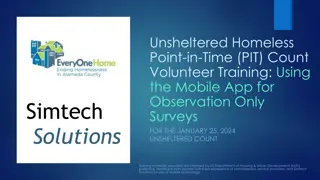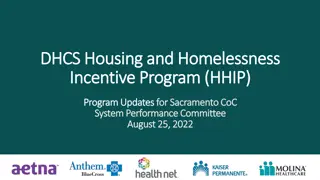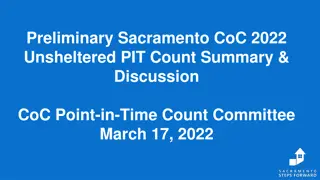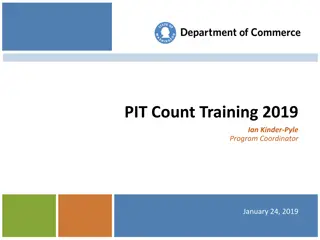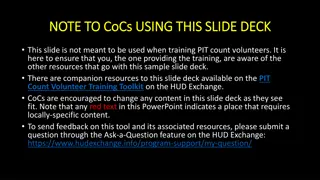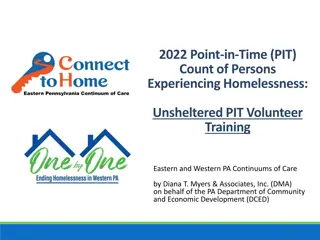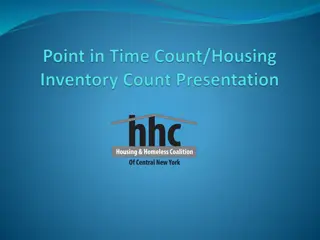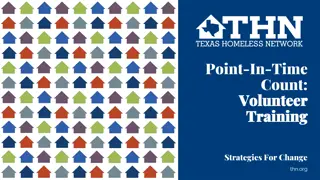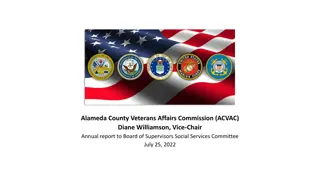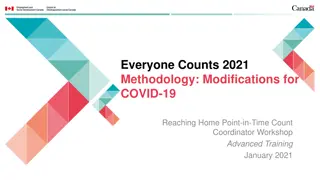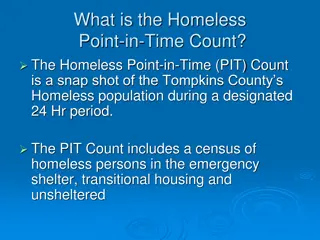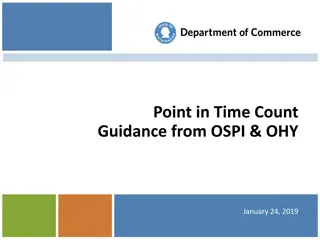Addressing the Intersection of Homelessness and Health
Exploring the critical issue of homelessness and its impact on health, this content delves into the challenges faced by individuals experiencing unstable housing situations. It highlights the early mortality rates and poor health outcomes associated with homelessness, particularly focusing on unshel
2 views • 27 slides
Unsheltered Homeless PIT Count Volunteer Training using Mobile App
The volunteer training for the January 25, 2024, Unsheltered Count involves using a mobile app for observation-only surveys. Training materials are based on HUD guidance and feedback from those with lived homelessness experience. Volunteers will be assigned locations to canvas and conduct surveys us
0 views • 7 slides
DHCS Housing and Homelessness Incentive Program Updates for Sacramento CoC System Performance Committee
Today's purpose is to discuss MCP's partnership on CoC Unsheltered NOFO and CoC NOFO leveraging healthcare resources, and provide an overview of direction for HHIP Investment Plan. The program timeline outlines deliverables and payments, with an emphasis on demonstrating progress on HHIP measures to
2 views • 25 slides
Point-in-Time Count of Unsheltered Persons Experiencing Homelessness - Volunteer Training Overview
Point-in-Time Count (PIT) is crucial for understanding and addressing homelessness. This volunteer training provides insights into counting unsheltered individuals, gathering demographic data, and why PIT counts are conducted. It emphasizes the importance of measuring trends, strategizing resource a
1 views • 40 slides
Sacramento CoC 2022 Unsheltered PIT Count Summary & Updates
Examining the preliminary findings of the 2022 Sacramento CoC Unsheltered Point-in-Time (PIT) count, this report discusses volunteer efforts, areas covered, and involvement of professional outreach partners. The document outlines future steps, including surveys, data analysis, and planning for the n
0 views • 12 slides
Understanding PIT Count Training for Homeless Population
This content provides insights into the PIT Count Training 2019 aimed at understanding and addressing homelessness. It covers topics such as unsheltered and sheltered counts, individuals included and excluded in the PIT count, and strategies to address subpopulations. Additionally, it clarifies what
2 views • 18 slides
Unsheltered Point-in-Time Count Volunteer Training Overview
This slide deck provides guidance for CoCs on conducting effective Unsheltered Point-in-Time (PIT) Counts, highlighting key training agenda topics, volunteer roles, survey practices, and logistic details. It emphasizes the importance of understanding who is counted in the PIT and the purpose of this
0 views • 48 slides
Understanding the 2022 Point-in-Time (PIT) Count of Persons Experiencing Homelessness
Learn about the significance of the annual Point-in-Time Count (PIT) conducted to measure homelessness trends, the distinction between sheltered and unsheltered counts, the guiding principles of the count, its purpose, and the specific locations where unsheltered individuals may be found. Explore wh
0 views • 44 slides
HMIS Participation Guidelines and Training Overview
HMIS participation guidelines and training provide detailed information for both sheltered and unsheltered homeless populations. The materials cover data entry requirements, assessment triggers, and street outreach enrollment processes. Non-HMIS programs have a separate entry process. Users are enco
0 views • 18 slides
Understanding Point-in-Time Counts in Homelessness Assistance Programs
Point-in-Time (PIT) Counts are crucial annual assessments conducted by Continuums of Care (CoCs) to enumerate sheltered and unsheltered homeless individuals on a single night in January. This count aids in determining homelessness trends, identifying vulnerable populations, and guiding resource allo
0 views • 12 slides
Point-In-Time Count Strategies for Homelessness Assistance
Snapshot of homeless individuals in a community on a single day to plan services, measure progress, and identify needs, strengths, and gaps. Process involves selecting a PIT lead, forming a committee, training volunteers, and counting individuals in various settings. Differentiates between who to co
0 views • 32 slides
Addressing Veterans Homelessness in Alameda County: ACVAC Initiatives and Programs
Alameda County Veterans Affairs Commission (ACVAC) is actively involved in providing advice and assistance to veterans and their families regarding basic needs, with a focus on housing and mental health services. This report highlights the key areas of concern for veterans in Alameda County, includi
0 views • 14 slides
Sacramento Funders Collaborative: Outreach Gaps & Opportunities Report
The report highlights the importance of focusing on outreach in Sacramento due to a large unsheltered homeless population. It discusses current outreach programs, data quality assessment, and analysis of outreach inventory in the region. Identified gaps and opportunities emphasize the need for proac
0 views • 12 slides
Enhancing Safety Measures for the 2021 Everyone Counts Point-in-Time Count Workshop
The 2021 Everyone Counts workshop emphasizes enhanced safety measures due to COVID-19. Modifications to the Point-in-Time Count aim to reduce risks and ensure compliance with local health guidelines. The workshop covers elements like unsheltered and sheltered enumeration, surveys, and key decision s
0 views • 32 slides
Overview of Homeless Point-in-Time Count in Tompkins County
Homeless Point-in-Time (PIT) Count in Tompkins County provides a snapshot of the homeless population within a 24-hour period, including those in emergency shelters, transitional housing, and unsheltered locations. It is conducted annually to gather data on the number and demographics of homeless ind
0 views • 27 slides
Point-in-Time Count Guidance and Overview from OSPI & OHY
The content provides information about the Point-in-Time Count Guidance from OSPI & OHY on January 24, 2019. It includes an agenda overview, details on unsheltered and sheltered counts, involvement of local school districts, and how schools can support the PIT Count. The guidance emphasizes the impo
0 views • 34 slides

